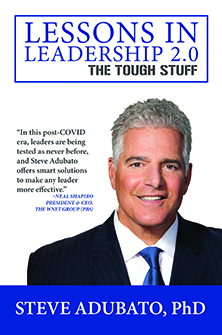
Leading Beyond Perfection
Wednesday, March 27, 2024
Unmasking the quirky, quizzical and quintessential maze in Lessons in Leadership 2.0: The Tough Stuff.
I’m fascinated with the subject of leadership. I’m constantly trying to understand why a particular leader handles a challenging situation one way while another takes a very different approach. Why are some leaders better equipped to face a crisis, obstacle or challenge while others panic and fold under the pressure? Why are certain leaders constantly innovating, reinventing and pivoting while others cling to the “status quo” as if this “status quo” is ever good enough? And the age-old question: Are great leaders born, or can you really teach this leadership stuff?
I wrote the original Lessons in Leadership in 2016, and many have asked me why there was a need for another leadership book, specifically, Lessons in Leadership 2.0: The Tough Stuff, which was just released. One reason is that I have learned many new “lessons” about leadership during that time. (Mostly because of making new mistakes and facing new challenges, as well as experiencing some leadership breakthroughs over more than six years.) I’ve also come to realize that my view of leadership has evolved significantly. I’m not so convinced that the so-called lessons and assumptions I wrote about in my last book are so rock solid anymore. One size definitely does not fit all.
Further, the world feels more complex, confusing and yes, scary, at times. At the very least, we can all acknowledge that today’s leaders navigate in a much more unpredictable environment including a multi-year, ever-evolving, global pandemic that impacted virtually every aspect of our lives. In many ways, exceptional leadership seems harder than ever. It requires a diverse and nimble skill set, an unprecedented degree of self-confidence and self-reflection and awareness, not to mention a healthy dose of “emotional intelligence.”
Here I share just some themes and excerpts from Lessons in Leadership 2.0: The Tough Stuff that should be helpful as we all continue to navigate in this constantly evolving environment.
The Wellness-Leadership Connection

Lessons in Leadership 2.0 The Tough Stuff by Steve Adubato, Ph.D.
Clearly, wellness and leadership involve a strategic, realistic, comprehensive and consistent approach to self-care. It is about limiting “screen time.” (I’m pretty bad when it comes to sometimes going down the black hole of social media and the internet.) Our wellness and the connection to how we lead are also about our mental health and getting the help we need in this area as opposed to thinking we can always “tough it out” in any situation.
That’s right, I am talking therapy. I’ve been there and, when needed, I still go there, because sometimes wellness (and leadership) is about knowing that we can’t simply handle it all ourselves and we need help from others who are experts at certain things that we are not.
But one important thing to remember: It is not just about making wellness a priority on a specific day. Real wellness is about a lot more than a morning workout, Pilates, yoga, or stretching, or sitting at a coffee shop on Friday mornings. (FYI: This is my current Friday morning “wellness” routine.) It is more than taking time to walk the dog or get things done around the house.
It’s about prioritizing your medical care and staying on top of health-related issues before it’s too late. Yes, preventative medicine. It is about managing stress, getting enough sleep, investing in the “relationship bank” with people who matter in our lives. I’m talking about family and friends, but it is also about trying to avoid or limit our contact with “toxic people” who always seem to come into our lives.
It is also about a semblance of this thing called “work-life integration” and perspective. I don’t even use the phrase “work-life balance” because I am not exactly sure that that means. What I do know is that when our work consumes the rest of our lives, and we are simply not able to turn it off, it often can have a very negative impact on our wellness.
I strongly believe that we have a basic responsibility to do all we can to prioritize our own well-being (obviously certain health and medical issues are beyond anyone’s control) as well as the well-being of every team member. Promoting a culture of wellness is not a check-off-the-box action that a leader takes, but rather a frame of mind and a value system that is established, revised, implemented and reinforced every day. It is about making a culture of wellness a part of your team’s DNA.
Is Everyone Really a Leader?
I’ve long believed that everyone on a team MUST be a leader for the team to reach
its potential. At the same time, I’ve often been frustrated when one team member or
another doesn’t take the lead on a project, initiative or challenge facing our organization.
So, is everyone really a leader? Or, can our or any organization or team succeed at the highest level of excellence with team members just doing their jobs within narrow parameters (stay in their lane) or doing what they are directed to do?
I’ve been in leadership positions long enough to know that this is not a black-and-white question. At one time or another, all of us must follow the lead of others. And yet, I still struggle with this complex topic. I have come to believe that to be a truly great team, every team member must step up — must take the lead — and must not hang back and wait for direction. To be clear, I’m not talking about an average or mediocre organization or team — I’m talking about an exceptional team with very high standards. (I’m talking about a team winning a Super Bowl or the World Series.)
I believe that everyone on your team should be a leader if your team is going to maximize its potential and truly be excellent. However, in many instances, I have seen too many professionals who simply choose to not take the initiative and not lead when the need or opportunity is right in front of them. I’ve worked with and coached many team members who appear to be comfortable and quite satisfied with still waiting to be told what to do.
Sure, I have seen assertive and proactive leadership, the kind that involves taking the initiative and saying something like this: “You know, Steve, I was thinking, we need to do XYZ in order to improve how we are handling ABC. So I propose that we …” However, on too many teams, those instances are too rare.
This kind of leadership, which is often situational, requires that employees get outside their comfort zone and out of their lane into a more proactive and assertive mindset about what they do and how they do it. Truly great teams and organizations don’t succeed because team members accept the status quo. So, in the end, is everyone really a leader? Not exactly. But should they be? Absolutely!
Why Leaders Must “Artfully Confront”
As leaders, we must confront or deal directly with difficult, challenging and often
uncomfortable situations. This is so easy to say, and so much harder to do. There
is nothing fun about confrontation, but when leaders refuse to or are incapable of
dealing directly with sticky situations, organizations pay a heavy price. I know from
personal and professional experience.
To be clear, I’m not talking about being unnecessarily argumentative or contentious, but rather the kind of thoughtful, courageous and strategic leadership and communication mindset that says, “This is not a good situation and if I as a leader and we as an organization don’t deal with it in a constructive and candid fashion, it will have a seriously negative impact on our team.”
Clearly, confrontation can be perceived and sometimes is a battle, a contest or a war fought by combatants who will either win or lose. I’m talking about an all-or-nothing mindset. But there is another way to look at confrontational leadership and communication, as an opportunity to confront an ongoing problem or challenge head-on.
To that end, consider some leadership tips and tools when artfully confronting:
- Empathize: Take the time to be more “others focused.” Think about what YOU would want to hear if you were on the receiving end.
- Manage your emotions: Regardless of the message you are delivering or receiving, emotions can easily become charged. The key is to keep your emotions in check – no matter what.
- Be solution-oriented: Don’t criticize or give negative feedback without offering a potential remedy to improve the situation.
- Have a strategy: Identifying your larger goals and knowing the main message you want to get across are keys to staying focus.
- Be flexible and agile: When you anticipate pushback, defensiveness or an outright rejection, you need to be prepared to adapt your conversational strategy accordingly.
Lessons in Leadership 2.0: The Tough Stuff is simply a recounting of my own leadership mistakes, shortcomings and the lessons I have learned in the process. You see, that’s the thing. As leaders, we never get to the so-called finish line. There is no perfect leader. Perfection is an illusion, but progress and improvement with a goal of being the best leaders we can be are all that really matters. My hope is that this book can help all of us in our challenging and often rewarding leadership journey.
This article originally appeared in the Spring 2024 issue of In the Lead magazine, from Stillman School of Business’s Department of Management and the Buccino Leadership Institute. The bi-annual magazine focuses on leadership perspectives from the field of health care, with content that is curated from leaders across the industry who share lessons learned from real-world experiences.
Categories: Business, Science and Technology
